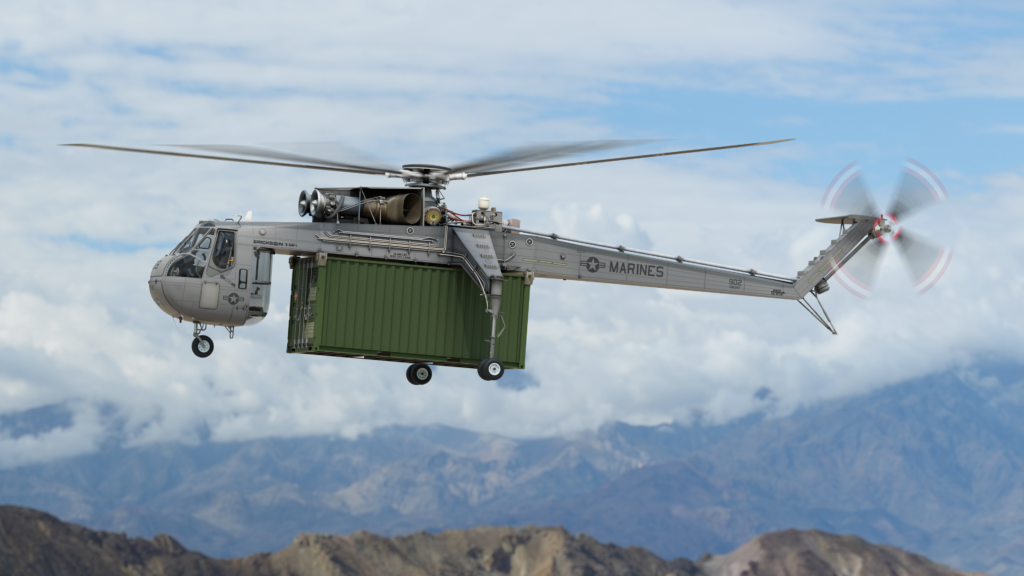Erickson Inc., answers three key questions around the future of heavy lift for the preservation of life, property, and defense missions.
Today’s civilian and military mission support, for firefighting or cargo transfer, demands innovative technology. For years heavy-lift helicopter technology has remained unchanged but is now coming into the 21st century with rapid upgrades
Modern heavy-lift military operations include ferrying cargo, firefighting, disaster recovery and more. Other military applications include bringing in heavy armored vehicles, modular hospitals, and other equipment, into visually obscured environments like jungles, forests, and at sea.
For over 50 years, the Erickson S-64 Air Crane® Helicopter has done a wide array of heavy-lift civilian and military operations. But now, as we enter the early 2020s, a new player is on the field. The S-64 is being upgraded with increased capacity and technology for even better mission support.
Questions often asked by mission strategists, pilots, crews, and government agencies:
- What innovative technology does the next generation S-64 contain?
- How does that influence the future of heavy lift in difficult mission environments?
- How will this technology change lifesaving and property missions?

1. Maximum efficiency with a modern heavy lift platform
The bar is being raised for efficiency in a heavy lift platform with the next generation S-64. For example, the composite main rotor blade is dramatically higher-performing, than metal blades, and is designed to transport heavy payloads with ease in hot and high environments. Erickson developed the new helicopter blades which were certified by the Federal Aviation Administration (FAA) in 2020 (view press release). Additionally, the S-64 airframe is unique because it allows any type of cargo to be either slung or flush mounted under the aircraft.
Erickson assumed the manufacture of the Sikorsky Skycrane in 1994 and has been running worldwide missions with aerial firefighting and military maneuvers ever since.
Erickson’s Sr. Director of Research and Development, Jeff Baxter, who has a history of innovating rocket technology with SpaceX said, “Without a fuselage, you can put anything under this thing,” which means better mission support with a variety of cargo and other add-ons.
But with rapid advances in Industry 4.0 and the Industrial Internet of Things (IIoT), the ability to capture data that will yield more results-based impact has become critical. The air crane model, brilliant from its inception has now been reconstructed with noticeable improvements. With IIoT, the physical properties of cargo lift are now improved with lighter weight of the aircraft and the ability to lift more payload – all while measuring data for rapid improvement.
The Vice President of Erickson’s Aviation Center of Excellence, Erick Nodland, a helicopter pilot himself has noted, that the early aircraft was a “physical, visceral experience,” the newest models require more mental acuity. He recently said, “The synergy of systems is critical,” as related to the challenging environments in which the S-64 Air Crane® aircraft operates.

2. Finding the right heavy lift platform for current and future cargo delivery needs
Fly-by-wire, which changed the way pilots control the aircraft by using electric signals instead of manual systems, was innovative. It took the aerospace industry 30 years to create the technology that we now carry in our pockets in the form of cell phones.
But the future is here with the necessary IIoT technology for improvements in cockpits for the technological precision expected by today’s pilots. The cockpit improvements have now been brought to the S-64F+ which is a boon for the industry. This along with Sikorsky’s MATRIX™ Technology autonomy suite with the S-64 enables autonomous operation in challenging environments. The MATRIX™ system will allow firefighting operations in reduced visibility environments, including in heavy smoke and after sunset, a capability that does not exist anywhere in the world today.
Tooling has also been simplified with the use of 3D printing within the aircraft manufacturing process. This is a tremendous cost reduction for aircraft production.
Last, improvements to turbo-shaft engines, have made future cargo delivery needs improved within a short amount of time in history.
3. Reducing risk when flying in remote and austere environments
Finally, for both defense and civilian missions, flying in high-hot conditions, and austere environments have been improved with this new technology.
Pilot-optional flights are coming soon which would allow, for example, aerial firefighting missions to be controlled remotely from a safe location on the ground. This would allow remote pilots to dip the water snorkel into a body of water, including salt and shallow water, to pick up loads throughout the night, dumping critical water on a rapidly spreading wildfire. These innovations will save lives and property in a rapidly changing worldwide environment.
The S-64F+ Air Crane® Helicopter by Erickson Inc., will be to market by 2024.
For more on these technologies, directly from the innovators at Erickson Incorporated, check out our recent webinars on The Future of Heavy Lift. These webinars offer a panel discussion with Erickson’s leaders who are asking the question – how can we improve the future of heavy lift?

